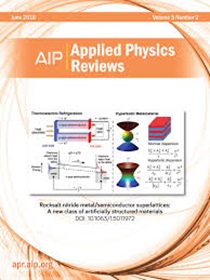Charge self-shuttling triboelectric nanogenerator based on wind-driven pump excitation for harvesting water wave energy
IF 11.9
1区 物理与天体物理
Q1 PHYSICS, APPLIED
引用次数: 0
Abstract
The most important ocean energy sources are wind energy and water wave energy, both of which are significant to carbon neutrality. Due to uneven distribution and random movement, the conversion efficiency from the two energies into electrical energy is limited, so the coupling of them is necessary. However, the current energy harvesting technologies generally target one certain type, or are simple mechanical coupling. Here, we propose a composite water wave energy harvesting scheme with wind excitation based on triboelectric nanogenerators (TENGs). A rotation TENG driven by wind is introduced as a pump to inject charges into the main TENG. For the main TENG driven by water waves, a specially designed charge self-shuttling mode is applied (CSS-TENG). Under the pump excitation, the shuttling charge amount is increased by 11.8 times, and the peak power density reaches 33.0 W m−3, with an average power density of 2.4 W m−3. Furthermore, the CSS-TENG is expanded into an array by parallel connection, and the practical applications are demonstrated. This work organically couples the wind and water wave energy in the ocean scene, through the charge pumping and self-shuttling mode, providing a new pathway for the synergistic development of clean and renewable energy sources.基于风动泵激励的充电自关闭三电纳米发电机,用于采集水波能
最重要的海洋能源是风能和水波能,这两种能源对实现碳中和意义重大。由于分布不均和运动随机,这两种能量转化为电能的效率有限,因此有必要将它们耦合起来。然而,目前的能量收集技术一般只针对某一种类型,或者是简单的机械耦合。在此,我们提出了一种基于三电纳米发电机(TENGs)的风能激励复合水波能量收集方案。我们引入了一个由风驱动的旋转 TENG 作为泵,向主 TENG 注入电荷。对于由水波驱动的主 TENG,采用了专门设计的电荷自关断模式(CSS-TENG)。在水泵激励下,穿梭电荷量增加了 11.8 倍,峰值功率密度达到 33.0 W m-3,平均功率密度为 2.4 W m-3。此外,还通过并联将 CSS-TENG 扩展为阵列,并演示了实际应用。这项工作通过电荷泵和自关闭模式,将海洋场景中的风能和水波能有机地结合起来,为清洁可再生能源的协同发展提供了一条新途径。
本文章由计算机程序翻译,如有差异,请以英文原文为准。
求助全文
约1分钟内获得全文
求助全文
来源期刊

Applied physics reviews
PHYSICS, APPLIED-
CiteScore
22.50
自引率
2.00%
发文量
113
审稿时长
2 months
期刊介绍:
Applied Physics Reviews (APR) is a journal featuring articles on critical topics in experimental or theoretical research in applied physics and applications of physics to other scientific and engineering branches. The publication includes two main types of articles:
Original Research: These articles report on high-quality, novel research studies that are of significant interest to the applied physics community.
Reviews: Review articles in APR can either be authoritative and comprehensive assessments of established areas of applied physics or short, timely reviews of recent advances in established fields or emerging areas of applied physics.
 求助内容:
求助内容: 应助结果提醒方式:
应助结果提醒方式:


